#Soshite Harukaze ni Sasayaite
Text
School Culture & Male Androphilia in Japan
[This is part of a series on Takumi-kun 6. The aim of this piece is to discuss the origins of student culture and male androphilia & how it plays out in Takumi-kun series.]

Takumi-kun series is an early BL novel by Shinobu Gotoh with an enduring legacy. It is also an on-going work as we follow Takumi-kun and others beyond their student (gakusei) days and into adult (shakaijin) life.
Takumi-kun series is mostly set in an all-males boarding school Shido Academy. As I have mentioned in my previous posts, pre-modern Japan has a long tradition of male androphilia[1], much of which was age-stratified, class-stratified or both and involved strict/normative inserter/insertee dichotomy. BL has inherited (such as in seme/uke dynamics) and bastardized (such as with younger seme/older uke pairing) traditions of male androphilia in its tropes. Let's discuss a bit of the history before diving into how Shinobu Gotoh plays around with the setup of boarding school male-male sexuality that emerged in the Meiji period.
Part 1
[ Main resource used for this part of the write-up is the chapter titled “Toward the Margins: Male-Male Sexuality in Meiji Popular Discourse” from the book Cartographies of Desire: Male-Male Sexuality in Japanese Discourse, 1600-1950 by Gregory M. Pflugfelder. ]
What Review of Senryu From Meiji Japan Reveals
Meiji period Japan saw transformation of Japanese customary male-male sexuality ‘within the newly established framework of a centralized nation-state’.
…male-male sexuality, which had enjoyed a prominent and respectable place in Edo-period popular texts, came during Meiji times to be routinely represented as “barbarous,” “immoral,” or simply “unspeakable.”
The marginalization of male-male sexuality can be traced through its representation in senryü verse composed during that period. In post-Meiji Restoration popular humor Yoshichö districts of Edo well-known for organized sex work was no longer associated with the kagema or male sex worker. Instead, it was associated with female geisha, mirroring the 18th centuary decline of kagema teahouse and their shutdown by local authorities'. Once mainstream male-male sex work had to go underground and faded from popular memory.
Just as old customs were forgotten, new ones emerged in senryu of 1880.
Two figures […] associated with male-male sexuality were the bantö and detchi—clerk and apprentice, respectively, in a commercial house. The bantö wielded considerable authority over other employees, and had been portrayed in senryü since the Edo period indulging his lechery with young male coworkers. The detchi, on the other hand, may be seen as the merchant version of the priestly chigo or samurai page boy: male adolescents for whom the favor or disfavor of senior males might have significant consequences for their professional advancement.
Meanwhile male-male sexuality involving Buddhist priests went from being considered ‘a lesser transgression than fornication with women’ and a ‘contradiction between the priest's personal indulgence and the ascetic ideals of his religion” to an “emblem of “ancient evils” (kyühei) in dire need of reform’ and ‘a criminal offense’.
Following period saw state regulation of representation of sexuality in media (print media, theatre and paintings - artist Kawanabe Kyösai’s erotic drawing of Meiji oligarch Sanjö Sanetomi & a male foreigner landed him in jail; not much different from jailing of ero BL creators in present day[2]) and a shift in popular discourse that deemed that male-male eroticism has no place in the “civilized” environment of Meiji. Male-male sexuality was further marginalized through silence resulting from ‘state censorship, editorial discretion, authorial inclination, public taste’, etc. Meiji journalists continued reporting on male-male sexuality but adopted a tone of moralistic outrage and condemnation.
In the demarcation of civilized behavior, male-male sexuality was relegated to ‘the Japanese past, the southwestern periphery, and the world of adolescence’.
Japanese Past
‘Male-male erotic practices lay in the past’ which was seen as ‘a backward and “feudal” age, whose institutions and customs Japan must abandon in order to achieve “civilization.”’
Meiji era authors depicted male-male sexuality with historical backdrop (such as samurai society of the Sengoku and Edo eras) that would excuse their representation in the name of historical accuracy. [This is in contrast to say depiction in cinema which has largely avoided depiction of nanshoku with exception of Taboo (1999) and Kubi (2023).]
Pflugfelder gives a couple of examples:
Higeotoko (Man with a Beard; 1890–1896) by Köda Rohan – very shonen ai about the whole thing – involved light hand-holding and fade to blank.
Kagema no adauchi (Kagema's Vendetta; 1899) by Jöno Denpei –about a professional “love boy”. As a person born in 1832 Jöno was familiar with male sex workers like the protagonist from his childhood. But the practice has thoroughly disappeared from the cultural fabric by 1899 that Jöno had to introduce the protagonist whose profession was “disgraceful” “from today's perspective” and his gender identity ambiguous.
Marginalization of Male-Male Sexuality Was Japan's Southwestern Periphery
Centered around Kagoshima prefecture (the former domain of Satsuma), the region encompassed various parts of Kyushu, Shikoku, and Honshu. During the Meiji period, it was popularly believed that male-male erotic practices were more prevalent here than in the rest of Japan. Other than the obvious geographic distinction, there was a social reason too for this distinction. It was believed the region was a stronghold of old customs with lasting imprints of samurai class and the high concentration of warrior families. Satsuma had customary homosocial groups with strict sex-segregation practices such as hekogumi and gojü until the Restoration.
Male-male erotic interaction […] was reportedly common within such groups.
… the martial ethos of the samurai class slowly dissolved under the pressure of social change and “civilized morality.” Contemporary observers correlated the deterioration of shiki or “warrior morale” with a decline in male-male erotic practices.[3]
During the Meiji period, southwestern region (Kagoshima in particular) was known for its male-male sexual practices. These practices were seen as regional peculiarities, distinct from the mainstream culture centered in Tokyo. The southwestern region was viewed as a “feudal” backwater, and the association of male-male erotic practices with this area underscored their perceived “uncivilized” nature. Instead of being seen as a universal practice [the way shudo was percieved], male-male sexuality was considered a “folkway” (füzokü) surviving on the cultural margins of a newly “civilized” nation-state. In the 20th century, sexologists further marginalized these practices by diagnosing regions like Kagoshima with a hereditary condition called “regional same-sex love” (chihôteki döseiai). This effectively contained male-male sexuality within specific geographical and cultural boundaries.
Moreover, from Kagoshima men’s regional identity imperial navy and seafaring got associated with male-male eroticism in Meiji Japan.
male-male sexuality & the world of adolescence
… the sexual object in shudö had always been defined as a young male. In Meiji popular discourse, as in that of the Edo period, it was generally understood that youthfulness formed one of the conditions of male-male erotic desirability. More and more commonly, however, the desiring party too was presumed to be an adolescent, older than his partner as a rule, but neither of them yet an adult.
‘Adolescence (seishun) as an “institutionalized moratorium between childhood and adulthood” [allowed for a] social space where adult standards did not fully apply’. This also allowed male-male sexuality which had gained the status of uncivilized behavior to be excused as ‘youthful folly’.
Institutions of formal education were around since Edo period and so was male-male erotic practices in them. Not only that but also ‘violence between rivals in love’. Following the Restoration, schools mushroomed throughout Japan with an added emphasis on education as a vehicle for social mobility. Students, tasked with future nation building, were expected to be diligent in their study and to stay away from sexual diversion. Male-male sexuality in schools were not just that in discourse of the day but was inextricably linked with ‘shifting definitions of masculinity, regional and political rivalries, and the ongoing “civilization” of morality’.
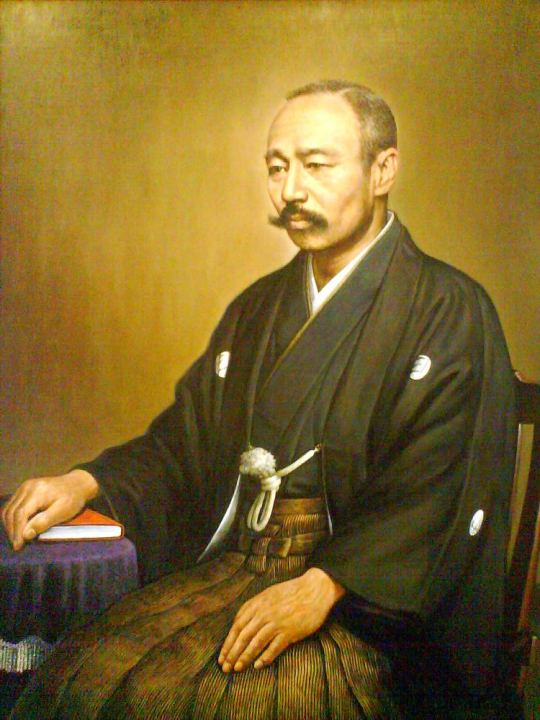
Mori Ögai - father of Mori Mari who wrote the first BL
Two terms born out of Mori Ögai's 1909 novel critiquing naturalism[4] Wita sekusuarisu (Vita Sexualis) köha and nanpa were used in discourses surrounding male-male sexuality among students. The term köha (translated as “roughnecks” by Pflugfelder and “queers” by Kazuji Ninomiya and Sanford Goldstein) referred to students who eschewed interest in male-female eroticism instead engaged in male-male sexual relations. This was in contrast to their nanpa (translated as “smoothies” by Pflugfelder and “mashers” by Kazuji Ninomiya and Sanford Goldstein) classmates.
[These are penetrator roles but not fixed categories. Students did move from one category to another even in Mori's novel. "Boy" (shonen) who were penetrated could take up penetrator role later on.]
“Smoothies” […] did not tuck up their sleeves or swagger about with menacing shoulders like their “roughneck” peers, but instead dandified themselves in silk kimonos and white socks (tabi) in order to win the favor of women.
In Mori’s school köha student were mostly from Kyushu and southwest Honshu prefecture of Yamaguchi while nanpa were from northeastern region. This regional distinction shows up in Tsubouchi Shöyö's novel Tösei shosei katagi (Spirit of Present Day Students; 1885–1886) wherein Kiriyama Benroku a quintessential köha is a native of Kyushu who wears coarse garb and is contrasted against his classmates womanizing peers not only by his leaning towards samurai ideals of masculinity but also by his interest in his companion Miyaga.
The köha-style of masculinity was modelled on engaging brute strength even in erotic dealings. Moreover ‘the strict age hierarchy that prevailed in student society constrained the very notion of consent, since junior males were in principle supposed to obey the dictates of senior schoolmates.’
In such an environment, male-male sexual practices often took a predatory form, with younger students providing fodder for older ones.
However, there were also non-forced köha-shonen sexual relations too.
Mori describes, for instance, a set of crude hand signals whereby a “boy” could consent to or refuse a senior male's overtures; subtler forms of seduction involved treats, favors, and the prospect of “special protection” (tokubetsu na hogo) by the older party.
Meiji newspapers was eager to cover köha violence wherein the older students who preyed upon “beautiful boy” in the streets of Tokyo and other Meiji cities or fought over a “beautiful boy”. They stood to gain readership especially those from middle- and upper-class who were likely to send their kids to boarding schools. It also fit well in the political context with journalistic crusade aimed at male-male sexuality & exploitation as a “Satsuma habit” in a time when ‘domination of the national government by the so-called “Satsuma clique” (Satsubatsu) faced mounting criticism’.
The portrayal of köha by journalists in post-Restoration Japan led to a strong association between male-male sexuality and adolescence. This association was so strong that any discussion of male-male sexuality would inevitably reference student societies and dormitories as common places for such relationships. Furthermore, accounts of school life often highlighted the culture of male-male eroticism as a distinctive feature. This is evident in memoirs by several notable figures such as Ösugi Sakae (himself a former köha), Iwaya Saza-nami, Ubukata Toshirô, as well as in literary works by Dazai Osamu, Hori Tatsuo, Kawabata Yasunari, Mushanoköji Saneatsu, Origuchi Shinobu, Satomi Ton, Tanizaki Jun’ichirö, and Uno Köji.
Chigo-nise ties (that is, erotic relationships between junior and senior youths) were reportedly common [in Kagoshima] as late as the 1940s, while student memoirs and other accounts describe similar attachments in schools outside the region. With the twentieth-century rise of the notion of [döseiai] “same-sex love,” however, popular representations of such relationships would come increasingly to focus on their psychological features, rather than on physical predation of the Meiji type.
The other half of the ‘asymmetric dyad that made up a male-male erotic relationship’, the sexually penetrated partner, is referred to as ‘shonen’ (boy) in student lingo. By then a mix of inherited knowledge from various arena – Japanese past, classical Chinese, and contemporary forensic pathology – entered public discourse such as seen in Kömurö Shujin's Bishönenron (On the Beautiful Boy).
In Kömurö Shujin's work, the primary effect of this paradigm was to bring to the fore the psychology and physiology of the “beautiful boy” in a manner that would become increasingly common as the century progressed. Kömurö Shujin cited an impressive array of Western authorities on “same-sex love,” most of them doctors or scientists who believed that the “passive” partner in male-male intercourse differed from others of his sex on the basis of certain mental and physical peculiarities, both inborn and acquired. At the same time, the author's understanding of Western sexology was filtered through a set of native assumptions, emerging in a form that often differed in telling ways from the intentions of the original theorists.
Masculinity of wakashu was rarely ever problematized during Edo period. But with the medicalization of male-male sexuality led to attribution of “effemination” with “passive” partner put forth by Western sexologists as Richard von Krafft-Ebing to gain traction in Japan and persist.
[Parallels can be found in bishonen (beautiful boy) stock in BL deemed feminine by readers unfamiliar with the bishonen aesthetics. For example, misattribution bishonen Ayase even when contrasted with feminine Someya in No Money. This also extends to treatment of seme/uke dynamics as though it is a reflection of heterosexual pairing when it is in fact a pairing of two different masculine aesthetics, not to ignore the misogynistic, xenophobic and colonial conception of men who do not fit into specific masculine aesthetics being deemed unmanly/feminine.
Interestingly, Miki Koichiro the director (and screenwriter) of Pornographer, Given, Zettai BL, Bokura no Micro na Shuumatsu etc. is well versed in the male androphilic traditions (among other queer traditions). We can see him using the term “shonen” when instructing the young actor playing Mob-san’s brother’s friend who has a crush on Mob-san. His usage was perfect, proving that he knows what he is doing.]
Part 2
Relics of traditional androphilia in Takumi-kun series
The norm or at least the expectation is that senior students (senpai) pursue pretty boy (bishonen) juniors (kouhai).
This is what outsiders expect even within the universe the novel series is set in as is seen from the conversation between Gii, his best friend Akaike Shouzou and Namiko (Shouzou’s girlfriend) in Sorera Subete Itoshiki Hibi (Those Were Precious Days), a part that never got live action adaptation.
This plays out in Takumi-kun series in various ways. There are two notable bishonen in Takumi-kun’s batch: Gii with his exotic beauty and the princess-like Takabayashi Izumi. In case of pursuit of Gii plays out in a pretty straight forward manner. He is relentlessly chased by seniors who are interested in Gii and their numerous attempts at wooing him.
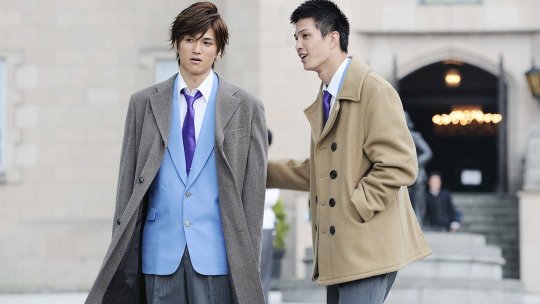
Takumi-kun 4 - Gii & Sagara
Notable pursuer is Sagara Takahiro who was in the third year when Gii joins Shidou. Sagara as the school president organized many recreational events hoping Gii would participate and they would grow closer. But Gii refuses to participate except for in the final one which took place in Sagara’s absence, the Shinto Shrine Hunt event that is depicted in Takumi-kun 6. Even though the pursuit plays out straight forwardly, it come to nothing since Gii is not there to be pursued. He is there to pursue Takumi-kun.
In case of Takabayashi Izumi, he turns his most ardent pursuers into a band of followers. This obedient little group of lackeys help him to stir up trouble for his love rival Takumi. Moreover, Takabayashi is one of Gii’s pursuers. This pursuit also doesn’t yield any result as Gii doesn’t entertain any pursuit.
Thus, both bishonen of Takumi’s batch subverts expectations surrounding bishonen by being pursuers.
Takabayashi’s plot gets further complicated when he falls in love with Yoshizawa Michio. Their pairing is that of weak seme x weak uke type – both are reluctant to actively pursue each other and requires external intervention to set their ship in motion.
Meanwhile Misu Arata wishes to be the target of his senior Sagara Takahiro’s affections. He actively participates in Sagara’s events wanting to get close [and they do get close as schoolmates] but Sagara is only interested in Gii.

Takumi-kun 4 - Shingyouji & Misu
Misu’s plot further deviates from the pursued bishonen track when a junior (Shingyouji Kanemi) pursues and eventually gets together with him in a clear inversion of the norm.
Takumi is also pursued by his seniors. Aso Kei’s pursuit is depicted in Takumi-kun 6 while Nozaki Daisuke’s attempts at courtship is depicted in Takumi-kun 1.
Aso Kei is the only one Takumi is comfortable interacting with apart from Katakura Toshihisa (Takumi’s best friend). Aso’s pursuit is aided by Gii who wholeheartedly wishes for Takumi’s happiness irrespective of whom he gets together with. Gii creates opportunities for Aso and Takumi to meet by delegating library duty to Takumi when Aso is around thus getting them to interact. Aso’s courtship fails and he takes it out on Gii by showing off – he lies to him that Takumi agreed to shrine hunt with him. When Gii notices that Takumi doesn’t reciprocate Aso’s feelings, he decides to actively pursue Takumi and turns from Aso’s enabler to rival in love.
Nozaki Daisuke’s pursuit of Takumi plays out within the senior pursuing junior set up. Another classic trope is that of love rivals fighting over a bishonen with both literary and in real life precedents. This is evoked in a race between Gii and Nozaki in Takumi’s name from Takumi-kun 1. Here the love rival’s competition is complicated since Gii is a bishonen who is fought over by many others (Takumi, Takabayashi, Nogawa Masaru*, etc).
* Nogawa Masaru is not depicted in any of the movies as far as I can remember.
Even though the novel series is called Takumi-kun series, there are many parts that doesn’t involve Takumi-kun and some of them are exclusively from the point of view of other characters. All in all, Takumi-kun series is like an anthology of many many love stories involving characters who are directly or indirectly connected to Takumi-kun. There are other stories involving younger pursuer and older pursued with all sorts of seme/uke arrangements. Here are some that I can recall right away:
Even guys who are not androphilic such as Akaike Shouzou gets pursued by seniors (Shibata Shun in Shouzou’s case). But these courtships are doomed from the get go.
Younger guy pursues older – senior & junior, teacher & student, etc.
senior x junior pursuit abandoned to establish senior x senior romance (Moriyama & Shibata) or junior x junior romance.
senior x junior romance sometimes end in heartbreak. (Takumi-kun 2)
senior x senior relationships are abandoned in pursuit of senior x junior relationship.
Sometimes seniors employ their seniority to retain power imbalance. (Misu and Shingyouji)
In case it is not clear, who pursues who has got nothing to do with who is seme, uke or riba and vice versa. Since the novel series involves many pairings, we get to see all sorts of seme/uke/riba dynamics (if we are to call it that given Takumi-kun is a June novel).
-
Footnotes
[1] I prefer using male androphilia because queerness is a bit too vague and in most case in inappropriate since it was the norm. Academics usually use male-male sexuality, male-male desire, male-male eroticism, etc.
Male androphilia must not be confused with the narrower term homosexuality.
[2] Danmei author Tian Yi and her companions were sentenced for 10 years for profiting from obscene content on male-male sexuality.
[3] while the courting of “beautiful boys” was a “barbaric custom” (banpü), domain authorities during the Edo period had tacitly encouraged it as a means of preventing young men from going “soft” (nyüjaku) through erotic involvement with women (joshoku).
[4] In the Company of Men: Representations of Male-Male Sexuality In Meiji Literature by Jim Reichert (199-208)
-
Takumi-kun meta series
1.Trailer plus
2.School culture and male androphilia in Japan. (you are here)
3.How does the movie compare with the source novel?
4.How does the movie compare with previous adaptations?
#takumi kun series#takumi-kun 6#japanese bl#タクミくんシリーズ 長い長い物語の始まりの朝。#タクミくんシリーズ#Gotoh Shinobu#Takumi-kun Series 6: The Morning of the Beginning of a Long#Takumi-kun Shirizu 6#タクミくんシリーズ6#Takumi-kun: The Dawn of the Long Tales#takumi kun 6#takumi kun 1#takumi kun 2#takumi kun 3#takumi kun 4#takumi kun 5#Takumi-kun Series 1: And The Spring Breeze Whispers (2007)#Takumi-kun Series 1: And The Spring Breeze Whispers#Takumi-kun Series 1#Soshite Harukaze ni Sasayaite#Takumi-kun Series 2: Rainbow Colored Glass (2009)#Takumi-kun Series 2: Rainbow Colored Glass#Takumi-kun Series 2#Takumi-kun Series 2: Nijiiro no Garasu#Takumi-kun Series 3: The Beauty of Detail (2010)#Takumi-kun Series 3: The Beauty of Detail#Takumi-kun Series 3#Takumi-kun Series 3: Bibou no Detail#タクミくんシリーズ3「美貌のディテイル」#タクミくんシリーズ3
6 notes
·
View notes
Text
A Definitive List of over 100 Films featuring Gay/Bi Men of Color
Macho Dancer (1988)
The Fruit Machine (1988)
Tongues Untied (1989)
Young Souls Rebel (1991)
Anthem (1993)
Farewell My Concubine (1993)
The Wedding Banquet (1993)
Shinjuku Triad Society (1995)
Happy Together (1997)
The River (1997)
Pusong Mamon (1998)
Hold you tight (1998)
Gohatto (1999)
Punks (2000)
Iron Ladies (2001)
Lan Yu (2001)
The Road to Love (2001)
Mango Souffle (2002)
Yossi and Jagger (2002)
Proteus (2003)
Brother to Brother (2004)
Formula 17 (2004)
Star Appeal (2004)
Chicken Tikka Masala (2005)
The King and the Clown (2005)
My Brother Nikhil (2005)
Boy culture (2006)
No Regret (2006)
RagTag (2006)
Blueprint (2007)
Soshite, Harukaze ni Sasayaite (2007)
Pleasure Factory (2007)
All of my life (2008)
Antique (2008)
City without Baseball (2008)
A Frozen Flower (2008)
Lovebirds (2008)
Noah’s Arc, Jumping the Broom (2008)
Boy (2009)
Do Paise Ki Dhoop, Chaar Aane Ki Baarish (2009)
Soundless Windchime (2009)
Bashment (2010)
Dunno Y Na Jaane Kyun… (2010)
Fit (2010)
KickfOff (2011)
Lost in Paradise (2011)
My Brother the Devil (2012)
Mixed Kebab (2012)
Morgan (2012)
One Night and Two Days (2012)
The Skinny (2012)
Speechless (2012)
Leave it on the Floor (2013)
La Partidoa (2013)
Peyote (2013)
Snails in the Rain (2013)
Hidden Away (2014)
Hot Guys with Guns (2014)
My Bromance (2014)
Night Flight (2014)
Praybeyt Benjamin (2014)
The Way He Looks (2014)
Yo Soy la Felicidad de esta Mundo (2014)
Aligarh (2015)
Beauty and the Bestie (2015)
Blackbird (2015)
The Blue Hour (2015)
Daddy (2015)
Eat with Me (2015)
Fire Song (2015)
How to Win at Checkers (Every-time) (2015)
Out in the Dark (2015)
Loev (2015)
Naz and Maalik (2015)
Thanatos, Drunk (2015)
Time Out (2015)
2 Cool 2 Be 4gotten (2016)
Dear Dad (2016)
Front Cover (2016)
LUV Don’t Live Here (2016)
Kapoor & Sons (2016)
Moonlight (2016)
The Pass (2016)
The Super Parental Guardians (2016)
Teenage Kicks (2016)
Alaska is a Drag (2017)
God’s Own Country (2017)
Method (2017)
My Son is Gay (2017)
Play the Devil (2017)
The Wound (2017)
I am Happiness on Earth (2018)
Noblemen (2018)
Dear Ex (2018)
I Miss You When I See You (2018)
Voyage (2018)
Kalel, 15 (2019)
The Panti Sisters (2019)
Socrates (2019)
Funny Boy (2020)
Your Name Engraved Herein (2020)
B-Boy Blues (2021)
Gameboys: The Movie (2021)
Barrio Boy (2022)
Bhaadai do (2022)
Cobalt Blue (2022)
Fire Island (2022)
Golden Delicious (2022)
Marry My Dead Body (2023)
Aristotle and Dante Discover the Secrets of the Universe (2023)
159 notes
·
View notes
Text
Trailer: Takumi-kun Series 6: The Morning of the Beginning of a Long, Long Story
Takumi-kun Series 6: Nagai Nagai Monogatari no Hajimari no Asa (2023)
On the day of Shido Academy’s entrance exam, Takumi witnesses Gii for the first time--
On the day of Shido Academy’s entrance exam, Gii (Giichi Saki), who stands out in a crowd with his striking presence, walks past Takumi Hayama in the hallway. Takumi is mesmerized by Gii’s exotic, attractive appearance. When school starts, Takumi is treated like a freak by his classmates because of his fear of touching and being touched by other people. But Takumi manages to get by, thanks to Toshihisa Katakura, his only good friend and roommate in the dorm. However, the peaceful days don’t last very long. In the library, third-year student Kei Aso asks Takumi to participate in the campus “shrine hunt” event with him. Izumi Takabayashi, who’s head over heels in love with Gii, and students who idolize Takabayashi start picking on Takumi. When Takabayashi realizes that his beloved Gii not only shrugs him off but is also interested in Takumi the freak, he gets consumed with jealousy and masterminds an attack on Takumi.
Spring comes, and Takumi and Gii are now second-year students. They’re assigned to the same room in the dorm, and their relationship gets much closer. Then Takabayashi makes another move and drives Takumi into a corner. Gii realizes Takabayashi’s plot and tries to save Takumi, however… And thus starts Takumi and Gii’s long, long sparkly story.



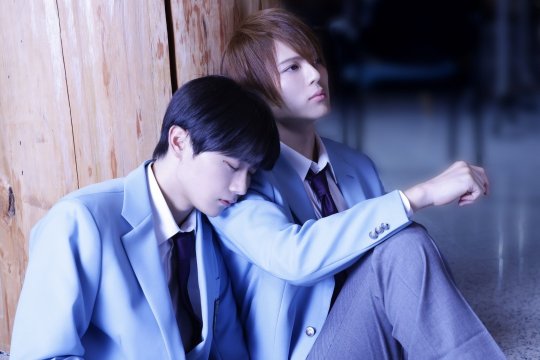




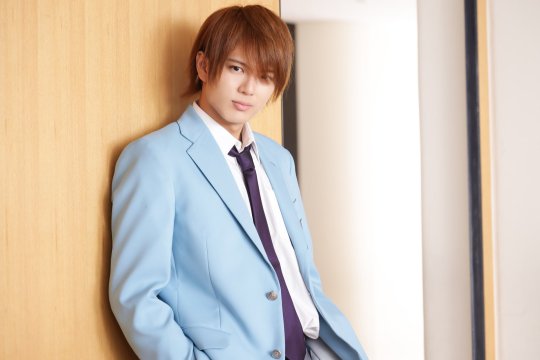
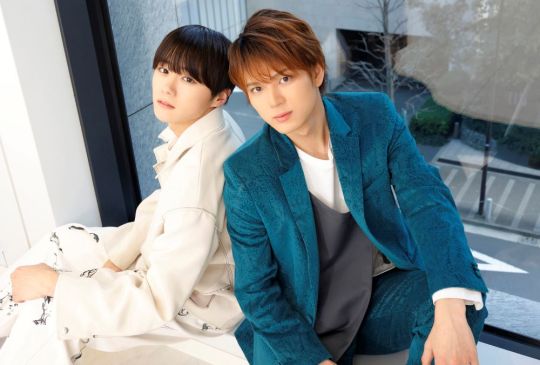
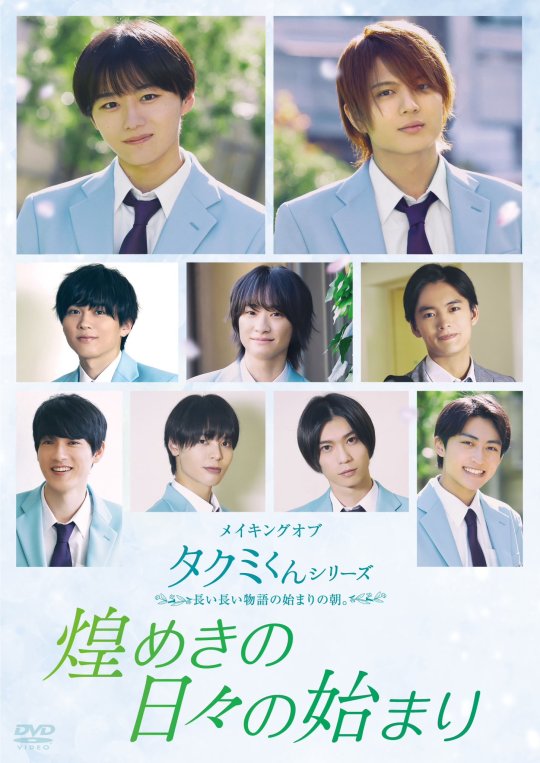
Introduction:
The beginning of Takumi and Gii’s sparkly days
Over 15 years since the first 2007 film adaptation of the Takumi kun Series, a popular “boys’ love” novel series with over 5 million copies in print, a new series has been launched with a new cast and story. The film is a combination of three titles from the Kanzen-ban 1 (omnibus edition) of the original novels—Akatsuki wo Matsumade (tr. Until I Wait for the Dawn), Soshite Harukaze ni Sasayaite (tr. And Then, I Whisper into the Spring Breeze), Nagai Nagai Monogatari no Hajimari no Asa (tr. The Morning of the Beginning of a Long, Long Story ). It portrays Takumi’s encounter with Gii on the day of Shido Academy’s entrance exam and the beginning of their sparkly days.
Takumi Hayama, one of the main characters, is played by Shion Morishita, a new actor stepping into the spotlight in 2023, and Giichi Saki (Gii), the other main character, is played by Daigo Kato, who is a musician as well as a cast member of musicals Touken Ranbu and HYPNOSIS MIC Division Rap Battle Rule the Stage. Other fresh talent in the cast adds vibrance to Shido Academy, namely Satsuki Nakayama of Kamen Rider Zero One as Izumi Takabayashi; Rio Takahashi, who models for magazine MEN’S NON-NO, as Shozo Akaike; Yusuke Noguchi of Hi☆Five as Toshihisa Katakura; Souta Uemura, an actor popular with teenagers, as Michio Yoshizawa; Ryunosuke Nagashima, who performed in HYPNOSIS MIC Division Rap Battle Rule the Stage, as Kei Aso; Kosei Tsubokura from a play called Promise of Wizard as Kenji Suzuki; and Tsubasa Kizu, who acted in the stage adaptation of Tokyo Revengers, as Arata Misu.
Screenwriter Hiroko Kanasugi and Director Kenji Yokoi, the same duo from the previous film who know the Takumi kun Series inside and out, are back together again. With a new screenplay and a new cast, they light the torch to the beginning of a beautiful, sparkly Takumi kun Series.
#takumi-kun series 6#takumi kun series#the morning of the beginning of a long long story#boys love#japanese bl#bl series#bl drama#jdrama
9 notes
·
View notes
Text
Takumi-Kun [1]: Soshite harukaze ni sasayaite

0 notes
Text
Tagged by @dunloth, thanks!
Rules: Tag 9 people you’d like to get to know better.
Top 3 ships: This is so hard but uh, off the top of my head, at the moment, Sakumo/Orochimaru, Madara/Tobirama, Shiro/Keith
Lipstick or chapstick: lip balm regularly, lipstick or gloss or tint occasionally, these days
Last song: When Darkness Spoke
Last movie: Takumi-kun: Soshite, Harukaze ni Sasayaite
Reading: Call of the Wild, Jack London
Tagging: @malakia215, @ohayohimawari, @i-drive-a-nii-san, @zacekova, @magnustesla, if you feel like it, and as always, consider yourself tagged by me if you would like to, duckies~
#tag game#Tumblr#Dunloth#about Kalira#whoops this got briefly lost in my drafts#like for a week and a half#>.>#found it again though!
9 notes
·
View notes
Photo

Takumi-kun Series
Japan // 2007-2011 // 5 movies
A series of movies about the love story between two boys living in a boarding school.
(1) Soshite, Harukaze ni Sasayaite: Takumi is surprised when his new roommate Gii confesses he has been in love with him for a long time. Takumi and Gii were recasted after this first movie with the actors in the picture above.
(2) Nijiiro no Garasu: Takumi grows jealous when Gii starts paying attention to a good-looking 1st year student.
(3) Bibou no Detail: Takumi is worried about Gii who has been suddenly acting cold and distant.
(4) Pure: Shingyouji is desperately in love and smitten by Takumi’s assertive roommate Misu.
(5) Ano, Hareta Aozora: It’s the 3rd year of high school and Takumi has an important anniversary to attend back in his hometown.
#takumi#takumi-kun#takumi-kun series#boys love#engsub#bringing back this classic#everyone who enjoys BL should watch these
96 notes
·
View notes
Text
Tag Index
*** [ 12.06.2018 ] I set up a new blog and transferred the username over after purging out anything NSFW to avoid deletion due to Tumblr’s new “no nsfw content” policy. Most of my posts —nsfw or not, and they were actually pretty tame since my 18+ content was on another blog— were getting flagged. We’ll see if this blog is still here by the 17th of this month (the deadline for nsfw blogs to get their shit together.) *fingers crossed*
** [ 05.14.2018 ] Blog got terminated for some unknown reason. Super pissed off about it (since I tagged my NSFW posts correctly, and even had my blog set to “adult.”) Working on building it back up again. :’(
* [ 06.23.2017 ] I accidentally deleted my blog and lost everything, so I have to rebuild this list back up again. :( Please be patient with me while I go through the list to reorganize and relabel.
General
18p - Nsfw/‘18 plus’ content (prn). No longer allowed.
boyslv - Gifs I’ve made.
favs - My favourites.
gifs - Gifs I’ve reblogged (usually not mine.)
imgs - Pictures, of course.
insta - Instagram posts, BL actors + real life couple accounts.
pnd - Prn I reblogged yet to watch. No longer allowed.
q - Queued posts.
vids - Videos (mostly trailers.)
boyslvc - My comments (often this tag will be followed with ’-’ and then my 2 cents. I usually just add my 2 cents in the tags section.)
(Movies and shows are below the cut.)
Movies/Shows
Bolded = Titles are flicks that feature a happy ending (for the BL couple.)
Italicized = Visible kiss scenes (I mean on the mouth and without a cut-away.)
* [Stars] = My favourites.
@ = Anime/Yaoi (Animated)
m = Minimal BL content
MV = Music video
x = Triggers (Those tagged as such may contain rape, suicide and/or violence. Proceed w/ caution.)
— = Pending (I haven’t seen it/its not out yet.)
— 2 Brothers (แผนลวงรักฉบับพี่ชาย)
— 3 Will Be Free
7 Days *
— 30 Years of Adonis
— 46 Billion Years of Love
A Crimson Mark
A Frozen Flower
A Round Trip to Love (双程》高泰宇x黄靖翔拍摄花絮) x
— Active Boys (Những chàng trai năng động)
Addicted (Heroin)
Ai No Kotodama * [Japan]
Ai No Kotodama 2
Alternative Love
Amphetamine x *
Antique Bakery *
Approach To Love
— Approach To Love 2
— As You Like It (偽婚男女)
Awakening Love (鈕扣)
Baby Steps *
Banana Fish @/m
Bangkok Love Story *
— Bangkok Stories: Please
— Be Here For You
Bite Fight (暮夜传说)
Boy Friend (男(朋)友)
CEO & His Man
Club Friday: The Series [2] (general tag: #clubfriday)
Club Friday: The Series [5] — The Secret of the Heart * (general tag: #clubfriday)
Club Friday: The Series [8] — True Love or Just Confused * (general tag: #clubfriday)
Club Friday: The Series [9] — Exchange of Love (ตอน รักต้องแลก) * (general tag: #clubfriday)
— Club Friday: The Series [10] — Exchange of Love (เขาเธอและอีกคน) (general tag: #clubfriday)
Coming Home
— Coming Out (カミングアウト)
Customized Companion
— Dark Blue Kiss
Edo of Candy (お江戸のキャンディー)
Eternal Summer
Fanatic Love (第一初恋)
Fathers
— Fall in Love with Chu Yan (爱上楚妍)
Feel Good To Say Goodbye
— Flyleaf of Summer
For Love, We Can
Formula 17
Front Cover *
Fujimi Orchestra x
Fujoshi Fantasy (腐女の盛夏誘惑)
Futureless Things (Korea) m
Ghost Boyfriend
Grey Rainbow
— Grounded (擱淺少年)
Heavenly Touch x
He Called Me (เขาเรียกผมว่า) *
Hello My Love (헬로우 마이 러브) *
Silhouette of Your Voice/Hidamari Ga Kikoeru (ひだまりが聴こえる) *
HIStory [1.1] - My Hero (general tag: #s history)
HIStory [1.2] - Stay Away From Me * (general tag: #s history)
HIStory [1.3] - Obsessed * (general tag: #s history)
HIStory [2.1] - Right or Wrong * (general tag: #s history)
HIStory [2.2] - Crossing the Line * (general tag: #s history)
— HIStory [3]
— How To Secretly
I Go To School Not By Bus
I Like You, Do You Know? (我喜欢你#你知道吗#我喜欢你。你知道吗)
In Love We’re All The Same (在愛裡我們都一樣)
John Apple Jack
Junjou Pure Heart
— Just Be Gentle
Just Friends *
Just Love (แค่ได้รัก)
Like Love [1] * (general tag: #likelove)
Like Love [2] * (general tag: #likelove)
Lost In Love (Qing hai mang mang)
Lost Love (特殊爱情)
— Love Lie Hide Fake
Love Love
Love Love You (Sequel of Love’s Coming)
Love Place [1]: Hakanaki Kataomoi~Gaiya no Koi
Love Place [2]: Shiawase no Katachi *
— Mayonaka kimi wa kiba o muku (真夜中きみはキバをむく)
Mother Strawberry Man (Mẹ Chồng Chàng Dâu)
Night Flight
No Different
One Night Only
Pair Of Love
— Blue Moon (파란 달)
People Like Us *
Red Balloon *
Red Wine In The Dark
Same Difference (どっちもどっち)
Schoolboy Crush
Stateless Things
Takumi-Kun [1]: Soshite harukaze ni sasayaite (general tag: #takumi)
Takumi-Kun [2]: Nijiiro no garasu (general tag: #takumi)
Takumi-Kun [3]: Bibou no diteiru (general tag: #takumi)
Takumi-Kun [4]: Pure (general tag: #takumi)
Takumi-Kun [5]: Ano, hareta Aozora * (general tag: #takumi)
— Thats My Umbrella The Series
The Lover
— Theory of Love
The Raccoon
Third Country 第三國度 */x
Timeline
— Timeline 2
Together With Me * (general tag: #kornknock)
Transmission
Udagawachou de Mattete Yo (Wait For Me At Udagawachou) *
Uncontrolled Love [1] (general tag: #uncontrolled)
Uncontrolled Love [2] (general tag: #uncontrolled)
— 2 Moons: The Series
— 99 Days
— A Queer Story
— Advance Bravely (盛势)
Ame To Kisu
— An Ordinary Love Story
Artemisia m
— Asymmetry
Bad Romance (general tag: #kornknock)
— Bangkok Online
— Bangkok Rak Stories 2
— Bao Bao/Dear Egg Man Diary (親愛的卵男日記)
— Beautiful (퀴어영화 뷰티풀)
— Because of meeting you, we can be here together (Vì gặp nên mới tương phùng)
— Because We.. Belong Together
— Befriend (China)
— Behind the Scenes: The Series
Between Ring & Pendant (夜)
— Big Bang Love: Juvenile A
Bishonen (Beauty) */x
Boku no Kareshi wo Shokai Shimasu (僕の彼氏を紹介します): Story 4
Bokura No Ai No Kanade *
Boy Meets Boy
— Boy/Friend
— Boyfriend (แฟนผมเป็นผู้ชาย)
Boys Love x
Boys Love 2 * x
Brave Together (勇敢在一起)
— Buddy Park (우정파크)
— Bungee Jumping Of Their Own
— Butter 2
— Butterfly (Korean)
— Call Boy (娼年)
— Change
Change Love…Never Change (รัก..ไม่เปลี่ยน)
— Cherries In Early Summer
— Chocolate, To You, For Me
— Choose
— Close To The Edge
Closer to You
— Club Friday the Series — To be Continued
Counterattack
Counterattack Special/Extra (逆袭之爱上情敌) *
— Dakaretai Otoko 1-i ni Odosarete Imasu @
— Dangerous Boys (Wai peng nak leng kha san)
— Dark Blue and the Moonlight (深藍與月光)
— December Town
— Diary (เสน่หา ตอน)
— Diary of Tootsies
— Does the Flower Blossom?
Do you, Andy (你願意了嗎) *
Docchi Mo Docchi
— Don't Give Up Your Destiny
— Don’t Want to Be Alone
— Don’t Worry
Doushitemo Furetakunai (No Touch At All) *
— Double Mints (Japan)
— Dream of Red Mansions (紅樓夢)
— Ducky Boy: The Series
Empty Nest
— End Of Love
— Enter The Phoenix
— Estranghero
— Even If The World Had Turn Against You
— Extra: The Series
Faded (淡淡) *
Farewell My Ghost Boyfriend (Hứa sẽ hạnh phúc nhé)
— Father & Son
— Forever Love (Tình Khiên Nhất Sinh)
— Forever Summer (きみのいた夏)
— Friendzone the Series
— Freshy (เสือ ชะนี เก้ง)
From Love Affair (純愛より) *
From Now to the Past (从现在到以前)
Gay Ok Bangkok *
— Give Me To the Wolf Director (把我交给狼主任)
— Go! Go! G-Boys
— Gohatto/Taboo (御法度)
Going South
— Goodbye Mr. X
— Gold (รูปทอง)
Gray (สีเทา)
— Green Light
— Happy Together [Movie]
— Happy Together [Show]
— Hatsukoi – First Love
— Hard to Come By
— Heart Beat: The Series
— He’s Coming to Me (เขามาเชงเม้งข้��งๆหลุมผมครับ)
— He Falls In Love With Him (青春自拍團 - 愛上她的他)
— How To Deal With Husband’s Mistress Case
— How to Win at Checkers (Every Time)
— Hush
— Hyeong Yeong Dang’s Diary
— I Am Not What You Want
I Am Your King: The Series
— I Don't Want You to Be Alone (我不愿让你一个人)
— Ikari (怒り) (Japan)
I’m Here & 12 Years (我们的十二年一个轮回这是传奇) *
— I Love you, buddy (Tao yêu mày)
— I Owe You
— In Between Seasons (환절기)
— Innate Differences (天生不同)
— Innocence (Bangkok Rak Stories 2)
— Innocence: The Series
Innocent
I’m Yours
— I Miss You When I See You (看見你便想念你)
— Imperfect
— It Gets Better
— It Seems To Rain
— It’s Complicated (เพราะรักมันซับซ้อน)
Itsuka No Kimi e *
— I Want to Marry Him - Only You
— Jack’d
— Jinroh Shokei Game (人狼処刑ゲーム ~たとえ君が狼でも僕は君を守る)
— Jinroh Shokei Game: Prologue
Kimi No Ita Natsu Zenhen
— Kindan No Koi
— Kiss Me Again (จูบให้ได้ถ้านายแน่จริง เร็วๆนี้)
— Kiss: The Series
— Kizumomo
— Lan Yu
— Let Love Heal
— Life Is Beautiful
— Like Grains of Sand
— Legend Of Mr. Fox (男狐传)
— Let Love Heal (Hàn gắn yêu thương)
Let Me Kiss You
Life Of Silence (犧牲之旅) *
— Like Love Special: He’s Always by Your Side
Long Time No See (롱타임노씨)*
— Lost
Lost In Paradise
Lost In Paradise (Hot boy nổi loạn) *
Lost In Paradise (Hot boy nổi loạn) 2
— Lost to Shame
— Love Actually Sucks
Love by Chance: The Series (บังเอิญรัก เดอะซีรีส์) *
Love In The Water (爱在水中央)
Love Next Door [1] (general tag: #lovenextdoor)
Love Next Door [2] (general tag: #lovenextdoor)
—Love Lie Hide Fake
— Love O-Net (Love Test)
Love Online m
— Love Sick: The Series
— Love Song Love Stories
— Love Strange Tide (รักแปลกแหวกติ่งฮา)
Love Unbound: Encounter at Chengdu
— Love Unbound: Encounter at Chengdu [2]
Love at First Degree
— Love of Siam
Love, 100°C
Love’s Coming
— Make It Right: The Series
Man on High Heels /m/x
— Malila The Farewell Flower (มะลิลา)
— Matching! Boys Archery
— Mermaid Sauna (美男魚澡堂)
Method (메소드)
— Mind (생각이 나서)
— Mister Merman
— Morning Boy
— Motorcycle The Series
— Mr Yan Dong! Don’t come over (颜冬先生别过来)
— My 17 Gay Friends
— My Best Gay Friends
— The Best Twin
— My Bromance
— My Bromance: The Series (我的鮮肉弟弟)
— My Bromance 2
My Brother
— My Brother’s Husband (弟の夫)
— My Day With In-Laws
— My Dear Loser
— My Dream: The Series
— My Eleventh Brother (형이 돌아왔다)
— My Engineer
— My Fair Son
— My Friend is Still Alive
— My Hero (พี่ชาย)
My Monster In Law (Mẹ Chồng Chàng Dâu) *
My Next life to love you / Love you again the next life MV
— My Pistachio (마이 피스타치오)
— My Sky (The Sky of Khanh)
— My Tee (อาตี๋ของผม)
— A Naked Boy/ Not Finished Yet (아직 끝나지 않았다)
— Natsuyami No You Na Ikkagetsu
— Never Again
— Never Trust a Stranger (Con Ma Nha Ho Vuong)
— Nine Shallow One Depth
No Regret
— Of Ants & Umbrellas
— Oops: Rainbow Coffee Shop
— Obsessed with Heart
One Day For Love *
— One Summer Night
— One Night and Two Days (White night) (백야) (Korea)
— Online: The Series
— Open (오픈)
— Oppressive Love: Queer Queen
Ossan’s Love * (general tag: #ossans)
Ossan’s Love [Series] (おっさんずラブ) * (general tag: #ossans)
— Oxygen The Series
— Our Last Day
— Our Sky: Pick and Rome
— Paradise In My Heart
— Part Time: The Series
— Permanent Residence (永久居留)
— Please: The Series
— Pornographer (ポルノグラファー)
— Predatory Tiger (เสือชะนีเก้ง)
Present Perfect (当下完美)
— Prison Playbook (Korea)
— Private Teacher
— Project S: The Series (Side by Side)
— Puppy Honey
— Puppy Honey 2
— Queer Movie Beautiful (퀴어영화 뷰티풀)
— Quite Ordinary
— REC
— ROSE: Last Love
— Rainbow
— Rainbow Boys: Right By Me (เรนโบว์บอยส์ เดอะมูฟวี่)
— Rainbow Eyes
— Raichi Hikari Kurabu (Lychee Light Club)
— Real Couple
— Remark (ไม่ได้เป็นอะไรกัน)
— Remember Alone Forever
Ren Ai Shindan: Tsubasa No Kakera
— Ren Ai Shindan: Unmei No Kodou
— River Knows Fish Heart (魚心河忍)
— Road Movie
— Roundabout
— SHADE
— Social Death Vote
SOTUS: The Series (general tag: #s sotus)
SOTUS S: The Series * (general tag: #s sotus)
Saigon, I love you (SÀI GÒN, ANH YÊU EM) /m
— Same Love
Same Same Is Not Same
— Sea of Lavender
Secret Love (密爱)
— Seek McCartney
— Shao Nian Chan Shi Guan (少年铲屎官)
— Silom Soi 2
Sisters (姐妹)
— Slam Dance: The Series
— Sodom’s Cat
Some
— Soundless Wind Chime
— Speechless
Suddenly, Last Summer
— Summerdaze
— Summer Memory (盛夏记忆)
Summer to Winter
— Super Academy Star (超星星学园)
— Super Star & Ordinary People (综艺小白和三栖巨腕)
— Sweet Boy
Swinging Blossom *
— Table Manners (테이블 매너)
Taiikukan Baby (Gymnasium Baby) *
— Tale of the Lost Boy
Tanabata (七夕特輯)
Teacher & Student
— Thanatos, Drunk
That Room (囚) * x
— TharnType The Series
— The Ambiguous Focus
— The Blue Hour
The Buddy/Brothers (哥们儿) *
The Coldest Day (한파) *
— The Course Of Life (Lifetime)
— The Depth (深度) (Japan/Korea)
— The Effect
— The Football Guys (Nhung chang trai san co)
— The Forbearance Lost (Chiếc Nhẫn Đi Lạc)
— The Gardener Club – Park Bench No. 8
— The Judges
— The King & The Clown
— The Sky You Don't Know (你不知道的天空)
The Male Dormitory
— The Male Queen
The Massage (마사지)
— The Meaning of the Promise (意许遗诺)
The Moment (ตัวอย่าง รักของเรา)
— The Monster (困兽)
— The Perfect Plan
The Perfect Man’s Man
The Person Who Always Goes Behind (Nguoi luon di phia sau)
The Postcard *
The Right Man (เพราะ…ฉันรัก)
— The Soldier Diary
The Spring in My Life (시절인연)
— The Tenants Downstairs
— The Two Mugs
— The Underwear
— The Wedding Banquet
— There Is No Space For Me
This Summer (今夏) *
— Tilted Summer (기울어진 여름) (Korea)
— To Each His Own (ちょっと今から仕事やめてくる)
— To You, For You
— Tomorrow I’ll Still Love You
Tree Deep, See Dear/Deep In The Forrest (树深时见鹿)
— Tropical Night (열대야) (Korea)
Twilight Night Legend (暮夜传说之嗜血男宠)
— Two Men's Persistent Basketball Rules (두 남자의 끈적한 농구법)
Two Weddings & a Funeral (두 번의 결혼식과 한 번의 장례식)
— Uncle & Son
— Uncoloured Rainbow (无色彩虹)
— Uniform
— U-Prince: The Series
— Utopians
— Waiting For the Wind
— Wake Up Chanee
— War Of High School
— Water Boyy
— Waterboyy: The Series
— We Are Gamily
— We Must Be Together
— What the Duck: The Series
— When I Got a Boyfriend (좋은 사람 생기면)
— White Night
Winter Cicada */@
Will You Still Love Me Tomorrow? *
— Yarichin Bitch Club @
— Yan Zhi Shan Hai Jing (颜值山海经)
— You and Me XXX
You Used To Smile That Way
艾咪拍拍
— 把我交给狼主任
JGV
This is really just a list of the ones I enjoyed for my future reference (but perhaps some of y’all might be interested in knowing the kinda stuff I’m into watching. xD) (Legend: 3 = e, 1 (sometimes) = i)
KR1084 (Genki & Ayumu)
[M3n’s Ru$h] - G3t F1lm] 2015 Summer
[M3n’s Ru$h] - G3t F1lm] GT-1240
[M3n’s Ru$h] - MR-KR837
[M3n’s Ru$h] - MR-KR666
[Pandora] My Sw33t D3v1l
[Pandora] Prem1um D1sc Vol.030 – YUK1ME — The bottom is so damn cute!
1 note
·
View note
Text
Takumi-kun 6 – trailer plus
Takumi Kun Series: The Dawn of The Long Tales
youtube
[Here’s a bit of an introduction to characters and plot. Covers the material directly lifted from the description box of the trailer. Contains mild spoilers.
The movie has been fan-subbed by furritsubs.]
Introduction
The beginning of Takumi and Gii’s sparkly days
Over 15 years since the first 2007 film adaptation of the Takumi kun Series, a popular “boys’ love” novel series with over 5 million copies in print, a new series has been launched with a new cast and story. The film is a combination of three titles from the Kanzen-ban 1 (omnibus edition) of the original novels—
Akatsuki wo Matsumade (tr. Until I Wait for the Dawn)
Soshite Harukaze ni Sasayaite (tr. And Then, I Whisper into the Spring Breeze)
Nagai Nagai Monogatari no Hajimari no Asa (tr. The Morning of the Beginning of a Long, Long Story).
[This is the order in which the stories appear in the omnibus edition. Third story is new addition to the novel series.]
It portrays Takumi’s encounter with Gii on the day of Shido Academy’s entrance exam and the beginning of their sparkly days.

Takumi Hayama, one of the main characters, is played by Shion Morishita, a new actor stepping into the spotlight in 2023

Giichi Saki (Gii), the other main character, is played by Daigo Kato, who is a musician as well as a cast member of musicals Touken Ranbu and HYPNOSIS MIC Division Rap Battle Rule the Stage.
Other fresh talent in the cast adds vibrance to Shido Academy:

Satsuki Nakayama of Kamen Rider Zero One as Izumi Takabayashi
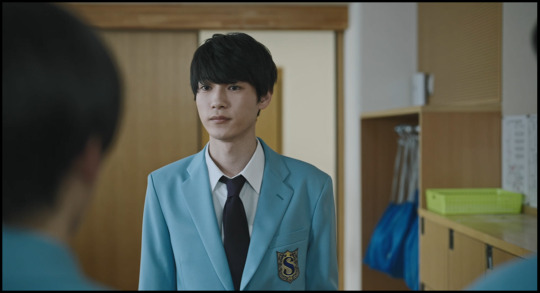
Rio Takahashi, who models for magazine MEN’S NON-NO, as Shozo Akaike

Yusuke Noguchi of Hi☆Five as Toshihisa Katakura

Souta Uemura, an actor popular with teenagers, as Michio Yoshizawa

Ryunosuke Nagashima, who performed in HYPNOSIS MIC Division Rap Battle Rule the Stage, as Kei Aso
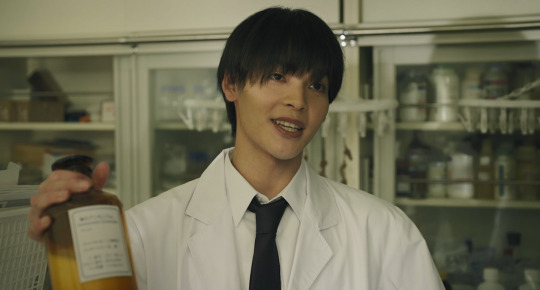
Kosei Tsubokura from a play called Promise of Wizard as Kenji Suzuki

Tsubasa Kizu, who acted in the stage adaptation of Tokyo Revengers, as Arata Misu
Screenwriter Hiroko Kanasugi and Director Kenji Yokoi, the same duo from the previous film who know the Takumi kun Series inside and out, are back together again. With a new screenplay and a new cast, they light the torch to the beginning of a beautiful, sparkly Takumi kun Series.
Story
On the day of Shido Academy’s entrance exam, Takumi witnesses Gii for the first time--



On the day of Shido Academy’s entrance exam, Gii (Giichi Saki), who stands out in a crowd with his striking presence, walks past Takumi Hayama in the hallway. Takumi is mesmerized by Gii’s exotic, attractive appearance.

[fan-subbed by furritsubs]
When school starts, Takumi is treated like a freak by his classmates because of his fear of touching and being touched by other people.

But Takumi manages to get by, thanks to Toshihisa Katakura, his only good friend and roommate in the dorm. However, the peaceful days don’t last very long.

In the library, third-year student Kei Aso asks Takumi to participate in the campus “shrine hunt” event with him.
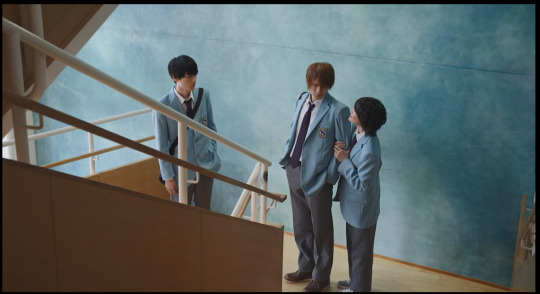
Izumi Takabayashi, who’s head over heels in love with Gii, and students who idolize Takabayashi start picking on Takumi.

When Takabayashi realizes that his beloved Gii not only shrugs him off but is also interested in Takumi the freak, he gets consumed with jealousy and masterminds an attack on Takumi.

Spring comes, and Takumi and Gii are now second-year students. They’re assigned to the same room in the dorm, and their relationship gets much closer.

Then Takabayashi makes another move and drives Takumi into a corner. Gii realizes Takabayashi’s plot and tries to save Takumi, however...

And thus starts Takumi and Gii’s long, long sparkly story.
-
Fan-subbed by furritsubs
-
This post is planned as a part of a series:
1.Trailer plus (you are here)
2.Introduction to the school culture and male androphilia in Japan.
3.How does the movie compare with the source novel?
4.How does the movie compare with previous adaptations?
#takumi kun series#takumi-kun 6#japanese bl#タクミくんシリーズ 長い長い物語の始まりの朝。#タクミくんシリーズ#Gotoh Shinobu#Takumi-kun Series 6: The Morning of the Beginning of a Long#Takumi-kun Shirizu 6#タクミくんシリーズ6#Takumi-kun: The Dawn of the Long Tales
3 notes
·
View notes
Photo

58 notes
·
View notes
Photo

TAKUMI-KUN (2007)
Título original: タクミくん シリーズ
País: Japón
Director: Kazuhiro Yokoyama
Categoría: Cine
Como primera de unas cuantas películas de Takumi me habían hablado muy bien de este live action yaoi, pero me he llevado una importante decepción.
Pienso que se ha exagerado el valor de la película solo por el hecho de que dos hombres se enamoren. ¿Acaso no tenéis ojos para daros cuenta de que la película carece de verosimilitud y sentido común? ¿Cómo es posible que en 15 minutos transcurridos ya le hayan pasado tantas cosas a Takumi (Yanagishita Tomo) y que su reacción sea totalmente indiferente?
Entiendo que es algo parecido a una 'bonita historia de amor' pero ya por eso no se puede catalogar de BUEN film.
Aún así, quitando todos esos momentos sin sentido, es un poco adictiva, más que nada por saber cómo termina y cómo es posible que hayan otras 3 o 4 películas más. Además, Giichi (Keisuke Kato) es bastante sexy y la pareja cumple perfectamente sus roles de 'seme' y 'uke'.
DESTACO el físico de los actores: algunos sorprendentes y otros amargos.
Puntuación: 1/5
#takumi kun#Giichi#Takumi & Giichi#Soshite Harukaze ni Sasayaite#Takumi kun series#live action#dorama japonés#yanagishita tomo#tomo yanagishita#keisuke kato#kato keisuke#yaoi#takumi-kun
4 notes
·
View notes
Text
Extensive Review - Takumi Kun Movie 1 (Soshite, Harukaze ni Sasayaite)
Psycho-Drama is launching a sort of blog-a-thon in anticipation of our upcoming review of Fujimi Orchestra - and we're featuring exclusive reviews of the Takumi Kun series. In Part 1, we're featuring Yojichan's extensive coverage of the first Takumi Kun movie - Soshite, Harukaze ni Sasayaite released in 2007

http://psycho-drama.com/index.php/film-reviews/325-takumi-kun-movie1
#Soshite Harukaze ni Sasayaite#Takumi Kun#takumi kun#Tomo Yanagishita#Keisuke Kato#takumi kun series
16 notes
·
View notes
Photo

124 notes
·
View notes